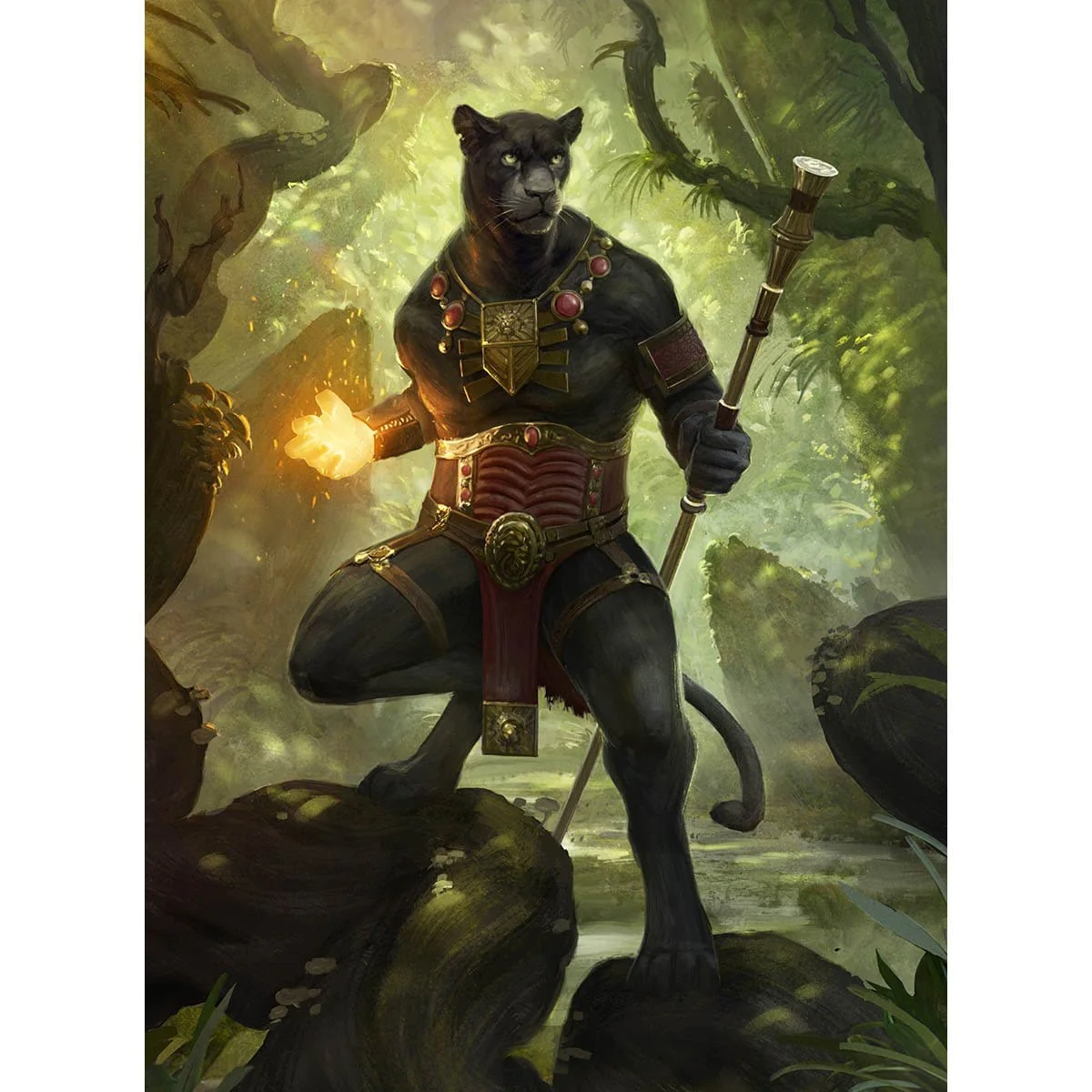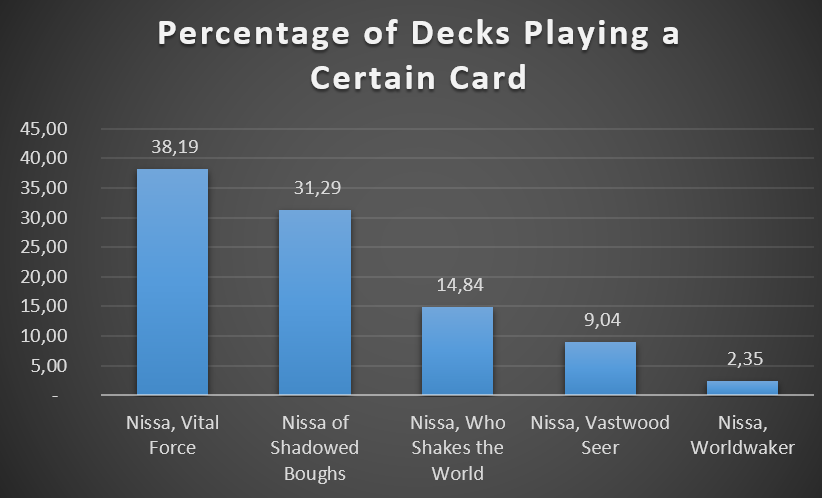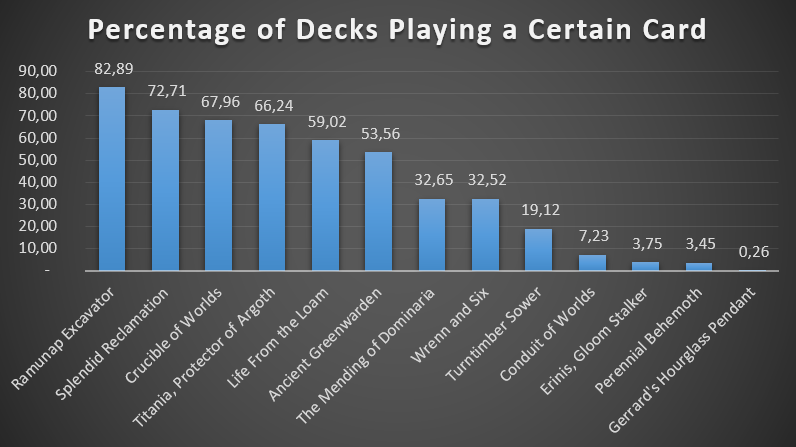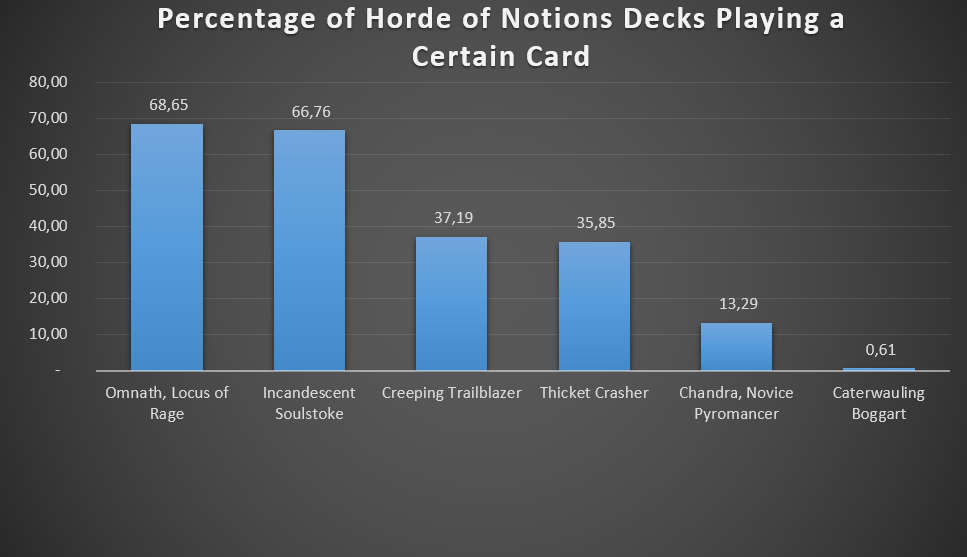(Lord WindgraceLord Windgrace| Art by Bram Sels)
Welcome to ElementaLand!
Hello everyone, and welcome back to Recross the Paths, a series that helps commanders to be seen under a new light.
Today I'll be talking about Lord WindgraceLord Windgrace. Everyone's favorite planeswalking cat has been using lands for many different purposes over the years, but I still think there's room for some innovation.
Stage One: The Deck
Clearly, lands are everywhere when playing a Lord WindgraceLord Windgrace deck. It doesn't matter if they're in your hand, if you threw them in the graveyard, or if you're just using them for mana. One way or another, they're propelling you towards the finish line. Today, however, we'll use them to actually win the game after turning them into Elemental creatures.
Step One: "Elementals"
There are mainly three ways for us to turn our lands into creatures.
First, at instant speed through cards such as Awakening of Vitu-GhaziAwakening of Vitu-Ghazi, Elemental UprisingElemental Uprising, and Kamahl's WillKamahl's Will, with each one of them shining for a different reason. The first one creates a huge body that sticks around, as the land will remain animated even with turns passing. The other two are basically sorceries due to the "until end of turn" clause, but they still have upsides to balance this out. On one hand, Elemental UprisingElemental Uprising is extremely cheap, meaning it can be used to gain a surprise blocker as well, but on the other hand, Kamahl's WillKamahl's Will contains another useful mode that could also be an added bonus to our main strategy if we cast it with our commander out.
Then, we can transform our lands into Elementals through a variety of creatures. In particular, Embodiment of InsightEmbodiment of Insight (just like Embodiment of FuryEmbodiment of Fury) shines for its easily repeatable ability to grant us creatures as well as to buff them. Next, Kamahl, Heart of KrosaKamahl, Heart of Krosa provides us with a cheap way to populate our board as well as giving us access to a potentially game-ending triggered ability, which is an issue that will come up in a moment. Last but not least, while a bit difficult to get going, Liege of the TangleLiege of the Tangle can turn out being backbreaking for our opponents, as 8/8 creatures are pretty good at finishing games fast.
Finally, we can rely on a number of planeswalkers to turn our mana into damage. Obviously, Nissa is an all-around MVP in this regard, with cards such as Nissa, Vital ForceNissa, Vital Force, Nissa, Who Shakes the WorldNissa, Who Shakes the World, and Nissa, WorldwakerNissa, Worldwaker being the most impactful ones.
Step Two: Lands From the Graveyard
As any other creature, our lands will end up in the graveyard sooner or later. Therefore, we need a certain number of ways to get them back in action. Alongside the evergreens, like Crucible of WorldsCrucible of Worlds, Ramunap ExcavatorRamunap Excavator, and Splendid ReclamationSplendid Reclamation, we can count on some newer tools to play with. Conduit of WorldsConduit of Worlds is the latest addition, and it comes with the upside of allowing us to cast permanent spells from our graveyard as well. Erinis, Gloom StalkerErinis, Gloom Stalker combines a powerful attack trigger with deathtouch, which allows it to swing more freely. Lastly, Perennial BehemothPerennial Behemoth can rely on a high toughness to stay around and grant us access to our destroyed lands.
Still, nothing can take away the crown from Life from the LoamLife from the Loam; it's easy to cast, it empowers itself, and it grants our deck resilience. I mean, what else can you ask a card to do for you?
Step Three: Land Tutors
While playing this list, lands will be much more than mana sources, so we need to gain access to the ones we need whenever we want to. For this reason, alongside the usual ramp pieces, such as Nature's LoreNature's Lore and Three VisitsThree Visits, we run land tutors that allow us to search for any land in our deck. Crop RotationCrop Rotation, Elvish ReclaimerElvish Reclaimer, and Realms UnchartedRealms Uncharted are very powerful cards that serve the double function of providing us with the cards we need and filling our graveyard, which is a zone we can and want to interact with easily. In this regard, ScapeshiftScapeshift can skyrocket us miles ahead of our opponents. Not only will we get to fix our mana and tutor the lands we need, but the ones we sacrificed are far from being gone forever.
Step Four: Ending the Game
As foreshadowed, our creatures need some help to close out games, as the longer the game goes, the higher are the chances of our lands disappearing. To this end, we run some ways to make it easier for our Elementals to connect. Caterwauling BoggartCaterwauling Boggart will grant them menace, Sylvan AdvocateSylvan Advocate will provide them with a good buff to their stats, and Thicket CrasherThicket Crasher will allow them to trample over our opponents' blockers. Remaining in the field of tribal synergies, Omnath, Locus of RageOmnath, Locus of Rage does a lot of work. On one hand, it creates additional attackers whenever we play a land, just in case we don't want to use the animated ones as attackers. On the other hand, and most importantly, it will deal damage whenever one of our Elementals dies, granting us a sort of repayment in case of board wipes.
Yet, we still need some further help to reduce others' life points to zero. For this reason, we include in our list some more known threats, such as Craterhoof BehemothCraterhoof Behemoth, End-Raze ForerunnersEnd-Raze Forerunners, and Triumph of the HordesTriumph of the Hordes.
Step Five: The Lands
This time around, the lands are a pivotal part of our strategy. In particular, creature lands that have an activated ability that turn themselves into Elementals are automatically included for obvious reasons. In fact, Hissing QuagmireHissing Quagmire, Lavaclaw ReachesLavaclaw Reaches, and Raging RavineRaging Ravine fit perfectly in this list, as they don't require any other card to start chipping away points from our opponents' life totals. Moreover, we can count on other lands with similar effects. Among them, Crawling BarrensCrawling Barrens is the best one, as it will keep on growing throughout the game
Step Six: Complete Decklist
Commander (25)
- 1 Lord WindgraceLord Windgrace
- 1 ["Elementals"]["Elementals"]
- 1 Awakening of Vitu-GhaziAwakening of Vitu-Ghazi
- 1 Clan GuildmageClan Guildmage
- 1 Elemental UprisingElemental Uprising
- 1 Embodiment of FuryEmbodiment of Fury
- 1 Embodiment of InsightEmbodiment of Insight
- 1 Ignition TeamIgnition Team
- 1 Kamahl's WillKamahl's Will
- 1 Kamahl, Heart of KrosaKamahl, Heart of Krosa
- 1 Liege of the TangleLiege of the Tangle
- 1 Llanowar LoamspeakerLlanowar Loamspeaker
- 1 Nissa of Shadowed BoughsNissa of Shadowed Boughs
- 1 Nissa's ZendikonNissa's Zendikon
- 1 Nissa, Vastwood SeerNissa, Vastwood Seer
- 1 Nissa, Vital ForceNissa, Vital Force
- 1 Nissa, Who Shakes the WorldNissa, Who Shakes the World
- 1 Nissa, WorldwakerNissa, Worldwaker
- 1 Silvanus's InvokerSilvanus's Invoker
- 1 Skarrg GuildmageSkarrg Guildmage
- 1 Sylvan AwakeningSylvan Awakening
- 1 Vastwood ZendikonVastwood Zendikon
- 1 Waker of the WildsWaker of the Wilds
- 1 Wakeroot ElementalWakeroot Elemental
- 1 Woodwraith CorrupterWoodwraith Corrupter
Lands from the Graveyard (13)
- 1 Ancient GreenwardenAncient Greenwarden
- 1 Conduit of WorldsConduit of Worlds
- 1 Crucible of WorldsCrucible of Worlds
- 1 Erinis, Gloom StalkerErinis, Gloom Stalker
- 1 Gerrard's Hourglass PendantGerrard's Hourglass Pendant
- 1 Life from the LoamLife from the Loam
- 1 Perennial BehemothPerennial Behemoth
- 1 Ramunap ExcavatorRamunap Excavator
- 1 Splendid ReclamationSplendid Reclamation
- 1 The Mending of DominariaThe Mending of Dominaria
- 1 Titania, Protector of ArgothTitania, Protector of Argoth
- 1 Turntimber SowerTurntimber Sower
- 1 Wrenn and SixWrenn and Six
Land Tutors (9)
- 1 Crop RotationCrop Rotation
- 1 Elvish ReclaimerElvish Reclaimer
- 1 Kura, the Boundless SkyKura, the Boundless Sky
- 1 Nature's LoreNature's Lore
- 1 Realms UnchartedRealms Uncharted
- 1 ScapeshiftScapeshift
- 1 Sylvan ScryingSylvan Scrying
- 1 Three VisitsThree Visits
- 1 Titania's CommandTitania's Command
Finishing the Game (11)
- 1 Caterwauling BoggartCaterwauling Boggart
- 1 Chandra, Novice PyromancerChandra, Novice Pyromancer
- 1 Craterhoof BehemothCraterhoof Behemoth
- 1 Creeping TrailblazerCreeping Trailblazer
- 1 End-Raze ForerunnersEnd-Raze Forerunners
- 1 Incandescent SoulstokeIncandescent Soulstoke
- 1 Omnath, Locus of RageOmnath, Locus of Rage
- 1 OverrunOverrun
- 1 Sylvan AdvocateSylvan Advocate
- 1 Thicket CrasherThicket Crasher
- 1 Triumph of the HordesTriumph of the Hordes
Lands (40)
- 1 Blood CryptBlood Crypt
- 1 Command TowerCommand Tower
- 1 Crawling BarrensCrawling Barrens
- 1 Deathcap GladeDeathcap Glade
- 1 Exotic OrchardExotic Orchard
- 1 Fire-Lit ThicketFire-Lit Thicket
- 8 ForestForest
- 1 Grove of the BurnwillowsGrove of the Burnwillows
- 1 Hissing QuagmireHissing Quagmire
- 1 Hostile DesertHostile Desert
- 1 Lavaclaw ReachesLavaclaw Reaches
- 1 Llanowar WastesLlanowar Wastes
- 1 Luxury SuiteLuxury Suite
- 1 Mana ConfluenceMana Confluence
- 1 Mossfire ValleyMossfire Valley
- 5 MountainMountain
- 1 Overgrown TombOvergrown Tomb
- 1 Raging RavineRaging Ravine
- 1 Reflecting PoolReflecting Pool
- 1 Rockfall ValeRockfall Vale
- 1 Savage LandsSavage Lands
- 1 Spire GardenSpire Garden
- 1 Stalking StonesStalking Stones
- 1 Stomping GroundStomping Ground
- 1 Sulfurous SpringsSulfurous Springs
- 1 SwampSwamp
- 1 Twilight MireTwilight Mire
- 1 Undergrowth StadiumUndergrowth Stadium
- 1 Ziatora's Proving GroundZiatora's Proving Ground
Artifact Ramp (3)
- 1 Chromatic LanternChromatic Lantern
- 1 Fellwar StoneFellwar Stone
- 1 Sol RingSol Ring
Stage Two: The Data Room
We’re now on to the last part of this deck tech: the data room. Was this deck idea actually unique? Let's compare the list against both the average Lord WindgraceLord Windgrace deck and against the average Elemental deck to see what we gained (and lost) in the process.
Step One: The Average Lord WindgraceLord Windgrace Deck
Although it's a pretty old commander, Lord Windgrace still holds a place as an extremely popular general. It's the second most played Jund commander and is 59th overall, with 6552 registered decks according to EDHREC.
The first thing we can notice is that Elementals are not usually associated with our commander. In fact, the only tribal card we play that is actually used in other people's lists is Omnath, Locus of RageOmnath, Locus of Rage, which is included in 67.64% of decks. Of course, this is not due to its synergy with Elementals, but rather for the payoff it grants upon playing lands.
Moving on to lands-animating spells, I was surprised to see that those don't see play here either. I tried to be more specific, analyzing the how much the Nissa planeswalkers are utilized.
While Nissa, Vital ForceNissa, Vital Force is the most popular, as expected, Nissa, Who Shakes the WorldNissa, Who Shakes the World is surprisingly not played that frequently, standing at an inclusion rate lower than 15%. On the other hand, Nissa of Shadowed BoughsNissa of Shadowed Boughs is another rightfully popular planeswalker, as it rewards you for playing multiple lands and it can also serve to cheat big threats into play.
The cards that allow you to get lands back from the graveyard form another group that is very interesting to analyze
In this case, there's a peculiar phenomenon that can be recorded. In fact, older cards, like Ramunap ExcavatorRamunap Excavator and Splendid ReclamationSplendid Reclamation, are basically always present, as they sit at 83% and 73% of inclusion rate, respectively. On the other hand, newer cards don't seem to be of interest for Lord WindgraceLord Windgrace players; not even those like Conduit of WorldsConduit of Worlds or Perennial BehemothPerennial Behemoth, which accomplish core actions of our strategy, see play, telling us about how high the bar is set for this kind of effects.
Step Two: The Average Elemental Deck
The most popular Elemental commander is Horde of NotionsHorde of Notions, with 1799 registered decks on EDHREC, so let's see how popular our Elementals-related cards are in this kind of environment.
The graph doesn't tell us anything groundbreaking. Omnath, Locus of RageOmnath, Locus of Rage and Incandescent SoulstokeIncandescent Soulstoke are extremely popular options, Creeping TrailblazerCreeping Trailblazer and Thicket CrasherThicket Crasher see some play, and Chandra, Novice PyromancerChandra, Novice Pyromancer is more of a niche choice. What really surprised me here is that only 11 decks out of 1799 played Caterwauling BoggartCaterwauling Boggart. While this card is not a game-changer, it grants evasion to all of our Elementals, which 630 more decks entrust Thicket CrasherThicket Crasher to do. Perhaps people prefer running in-tribe options for better synergies, so I decided to look a bit more into the Elementals played in the average Horde of NotionsHorde of Notions list.
I highlighted the creatures that have at least some sort of synergy with other Elementals. Unexpectedly, just 10 out of 33 (30,3%) played fall in this category. Also, we have to consider that this number includes cards like Omnath, Locus of the RoilOmnath, Locus of the Roil and Titania, Nature's ForceTitania, Nature's Force, which are interested in fellow Elementals only to a certain extent, so I decided to look at how many Horde of NotionsHorde of Notions decks actually care about creature's type.
 The numbers are quite clear: in a list that usually runs 35 creatures, only 2% of the players include 10 that have tribal synergies. Perhaps this is due to the lack of real payoffs for Elementals-only strategies, which transforms commanders such as Horde of NotionsHorde of Notions in piles of cards that happen to be of a certain creature type.
The numbers are quite clear: in a list that usually runs 35 creatures, only 2% of the players include 10 that have tribal synergies. Perhaps this is due to the lack of real payoffs for Elementals-only strategies, which transforms commanders such as Horde of NotionsHorde of Notions in piles of cards that happen to be of a certain creature type.
Takeaways from Today's Article
- There is room for innovation in Lord WindgraceLord Windgrace decks, but it comes at the price of a much more risky gameplan. In fact, using our lands as beaters also exposes them to removal. Still, our commander forgives our hazardous moves, as it can easily get us back the lands we lose.
- There is an abysmal lack of interactions between Elemental creatures. The only ones that actually care about this creature type are either connected to other archetypes, such as Risen ReefRisen Reef, or simply not that impactful, such as SmokebraiderSmokebraider. This somehow forces Elemental decks to spiral down into being piles of cards rather than synergistic lists.
- There are some goodies arriving in the near future; in fact, as soon as Wrenn and RealmbreakerWrenn and Realmbreaker is released, it will be included in this list, as every single one of its abilities are relevant and powerful in this shell.
- All in all, I tried very hard to make this a functional Elementals deck, but I can't help but feel as if we're still some cards away from it being an actual archetype in commander.
- Lastly, I also considered doing a similar Atraxa, Praetors' VoiceAtraxa, Praetors' Voice deck centered around the Awaken ability. If you want me to develop it into an actual list, let me know in the comments below!
That’s all from me for the moment. I hope you enjoyed this deck tech, but now it’s on to you: what do you think of it? Would you have changed anything? Or there’s something you particularly liked? Most importantly, do you believe this was a true innovation? Let me know in the comments below!
Jonathan Zucchetti
Jonathan is an Italy-based Magic enjoyer that has been playing, although with some pauses, ever since Mirrodin released. His passion for EDH bloomed in 2018 and, with it, the love for exotic and underrepresented builds. When he is not complaining about an “unfair” removal, you can find him fiercely defending his Delver of Secrets at a pauper table.
Your opinions are welcome. We love hearing what you think about Magic! We ask that you are always respectful when commenting. Please keep in mind how your comments could be interpreted by others. Personal attacks on our writers or other commenters will not be tolerated. Your comments may be removed if your language could be interpreted as aggressive or disrespectful. You may also be banned from writing further comments.




